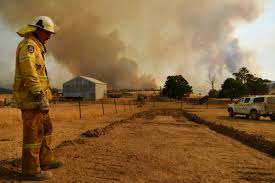Firefighters say they are becoming more traumatised on the frontline of the bushfire crisis knowing they could have saved more lives and homes had they been properly resourced.
In a letter to the Morrison government, emergency chiefs claim some fire preparation works were being performed by crews two-thirds of the size than usual.
The six emergency union chiefs who signed the letter have called on the bushfires to be considered a “national problem” as they urge a full inquiry into how states and territories budgeted for the season.
It will be years before fireys and other emergency service workers will experience “the full impact that this fire season will have on their physical and mental health”, they wrote.
“They know that agencies are not properly funded to fight these fires, to deal with the recovery from these fires, and to prepare for the fire season to come.”
The leaders wrote to Natural Disasters and Emergency Management Minister David Littleproud that “more lives and property could have been saved” but firefighting efforts were hampered by poor budget and resourcing decisions.
Former fire chiefs have previously warned the federal government about the need for greater action on climate change to prevent the fire threat. They say their advice was ignored.
The letter to Mr Littleproud was signed by NSW Public Service Association boss Stewart Little, NSW Fire Brigade Employees Union head Leighton Drury, Queensland United Firefighters Union boss John Oliver, SA UFU chief Max Adlam, WA UFU head Lea Anderson and NSW Volunteer Firefighters Association leader Mick Holton.
They said a royal commission must investigate how states and territories funded firefighting efforts.
The also letter reveals opinion is divided over whether a royal commission is necessary. On Wednesday, the United Firefighters Union of Australia penned a letter to the Prime Minister, saying there had already been scores of bushfire-related inquiries over the past two decades.
Instead of a royal commission the Prime Minister should set up a Council of Australian Governments audit all of the existing recommendations that haven’t been implemented, the union believes.
Mr Morrison is preparing to take a proposal for a bushfire royal commission to federal cabinet.
The state response to his idea has been lukewarm, with Victoria and NSW announcing their own inquiries into the bushfires.
The world’s second-warmest year on record
Australia’s unprecedented bushfire crisis has come after the second-hottest year since records began 140 years ago was recorded last year, the World Meteorological Organisation revealed on Thursday.
Data from the Geneva-based WMO showed the average global temperature in 2019 was 1.1 degree above pre-industrial levels.
This will likely lead to more extreme weather events, such as the Australian bushfires in 2020 and beyond, WMO Secretary-General Petteri Taalas warned.
“Australia had its hottest, driest year on record in 2019, setting the scene for the massive bushfires which were so devastating to people and property, wildlife, ecosystems and the environment,” Mr Taalas said.
“Unfortunately, we expect to see much extreme weather throughout 2020 and the coming decades, fuelled by record levels of heat-trapping greenhouse gases in the atmosphere.”
Weather warnings
Firefighters are hoping that much-needed rain and thunderstorms which are forecast to sweep across New South Wales will help douse the 88 fires still burning across the state.
Most of NSW is expected to receive rain from Thursday, except for the west and southwest, with the falls to continue into Monday.
Areas around the South Coast and Southern Tablelands are predicted to receive up to 30mm but the Bureau of Meteorology says the rain will be patchy and exact falls are difficult to predict.
The NSW SES says this could bring on the risk of flash flooding, falling trees and landslips after fire wiped out trees and growth.
“The NSW SES is also asking residents in fire affected areas to watch for possible landslips as the ground and roads can be damaged, therefore creating a higher risk of a potential slip,” NSW SES assistant commissioner Paul Bailey said.
In Victoria, authorities warn thunderstorms that hit the state on Wednesday might mean more bushfire trouble.
Lightning ignited fires in southern Victoria’s Great Otway National Park on Wednesday and authorities fear it could do the same in the fire-ravaged East Gippsland and north east regions.
Thunderstorms are also likely to produce damaging winds and carry large hail and heavy rainfall leading to flash flooding.
There were 19 active fires across Victoria on Wednesday by 10pm, with eight ‘Watch and Act’ alerts in place.

